All edible - to a greater or lesser extent
Clouded agaric Clitocybe nebularis
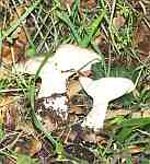
Oak milk cap Lactarius quietus
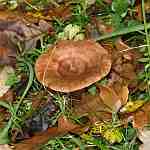
Lepista sordida
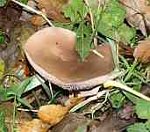
Snowy wax-cap
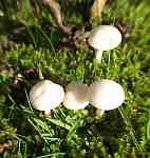
Agaricus silvaticus
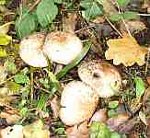
Morchella gigas
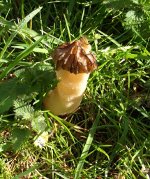
Rhodocybe_gemina
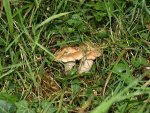
Blusher Amanita rubescens
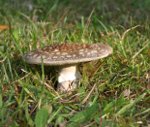
Girolle - Cantharellus cibarius
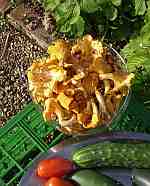
NOTES
Clitocybe nebularis clouded agaric - can upset some people: indeed, many books list it as 'suspect' or 'to be avoided'. Though I've been enjoying them for upward of fifty years, I suggest that rather than have a vast fry-up when you find a clone (and you can sometimes find hundreds of them together) they should be tried in small amounts - say a quarter of a cap - and then work upwards to the plateful.
Lepista sordida, like its close relative the wood blewit Lepista nuda should not be eaten raw as they haemolise the blood.
The blusher Amanita rubescens is distinctly poisonous raw, though fried (thoroughly), it is my very favourite mushroom.
|
Warning! Never eat any wild mushroom unless you know what it is, and that it is safe for you to do so.
most people can eat Clitocybe nebularis (clouded agaric), agaricus xanthoderma and friends (yellow-staining mushrooms), Macrolepiota rhacodes (shaggy parasol mushroom) and others, but a proportion of the population is upset by one or some of these - and others.
Do not use any pictures in this document for identification purposes...
It is always best, though not always possible, to get your knowledge by identifying fresh specimens under the tutelege of an expert rather than relying on a field guide.
Do not eat any wild mushroom raw unless you know it is safe to do so.
Many good edible species can be poisonous to a greater or lesser extent when not cooked thoroughly. Examples are Lepista saeva (blewits, bluelegs, bluestalks), Lepista nuda (wood blewits), Lepista sordida, Boletus erythropus, Amanita rubescens (blushers).
Remember, there is no mushroom that you cannot eat, but some of them you can only eat once....

Pickled Lactarius Torminosus / L. pubescens (AKA 'woolly milk-cap')
L. torminosus is the larger of the two species and the more common, and is, like L. pubescens, woolly - but unlike L. pubescens, which sometimes has a slightly pink blush to it - as of a Reubens' subject, L. torminosus is distinctly pink - less like a Reubens and more akin to the late Barbara Cartland in her pomp.
NB - pink and fluffy it may look, but there its promise ends - at least, until it's cooked.1 The same, barring the pinkness can be said of L. pubescens.
1 Parboiled2
2 Boiled vigorously
I would not recommend the use of a microwave oven in the initial boiling as the process involves leaching as well as cooking. I can't say it wouldn't work because I haven't tried it: I just treat the idea with a healthy dose of suspicion. Neither of the two species is dangerous though, even raw, but they are very acrid and strongly emetic, and anyone nibbling one only thinks he3 is dying.
3 or she
Henriette Kress - Hetta - is a Finnish mycologist and herbalist I have known for agesandagesandages, and she (and Finns tend to rate highly the mushroom) told me how to prepare both species.
(Pedantic) Note: 'Boiling-point' in this text means the boiling-point of water at NTP at or (relatively) close to sea-level.
Qualification of note: But it has to be pointed out that woolly milk caps are found (relatively) close to sea-level.
Pick, cut off base of stipes and wash mushrooms thoroughly. Being one which lurks amongst the grass roots, it is usually well-endowed with sand and composty bits, and these tend to infest the woolly surface of the cap. If all traces of Applied Geography are not removed it could spoil your enjoyment of the mushrooms...
Leave stalks on the caps because the whole of the mushroom is of a pretty even texture and unusually, the stipes are not fibrous. Place mushrooms in an excess of cold water in a saucepan and bring to the boil fairly slowly.
Note: If you were to just dunk them in boiling water and leave them there for ten minutes, you risk not treating completely the deepest parts of the larger caps, as tipping them in will reduce immediately the temperature of the water, and it will take longer than you might think for the temperature to rise to boiling-point in the centre of the thicker portions of the mushrooms.
When the whole boiling of them ('boiling'? Apposite, or what?) is seething, raise the boil to a gallop and keep it there for at least ten minutes, topping-up with boiling water if necessary to keep the mushrooms more-or-less covered. (They will break the surface, but as long as the water flows over them, this is OK.) You can be fastidious and place some sort of weighty rack over them to keep them submerged, but I've never found the necessity.
After ten or more minutes, remove the mushrooms from the heat and tip away the water. Add cold water to rinse them.
The mushrooms may now be prepared and fried, pickled, or added to soups, stews and casseroles - or indeed, used as you would your greengrocer's type.4
4 Agaricus bisporus
The flavour of the woolly milk-caps is not strong, and is rather reminiscent of pine. I suggest that they would complement wild capercailzie, as this bird is reputed to taste like turkey cooked in turpentine.
The Scands tend to pickle the mushroom, for which it is well suited. For this treatment, prepare some good quality vinegar by adding herbs and spices, then raising it to boiling point very slowly.
To preserve the delicate flavour of San Izal the nuance of pinewoods, the favourite vinegar would be Champagne, followed by white wine, then cider, then red wine, and lastly, but not ghastly, malt. In my opinion spirit vinegar5 is too raw, and balsamic, too powerful.
5 Only suitable for dousing deep-fried battered Mars Bars
Pack the caps in a jar and pour over them the hot spiced vinegar. Make sure they are well covered.
A finer method is to pack a screwtop jar to within an inch and a half of the top with the prepared6 mushrooms interspersed with a couple (more if liked) of chillis; a couple of uncut cloves of garlic (but with the dry sheath removed!); sprigs of herbs such as marjoram and sage; three or four fresh bay leaves; then two heaped teaspoons of black peppercorns; half a dozen cloves (or a teaspoon of allspice corns); around two rounded (tangled?) teaspoons of pieces of dried mace; and a small amount of sea salt.
6 'Prepared' meaning trimmed, washed and parboiled.
Cover the contents with the vinegar. you will have to scuttle the chillis by making small holes at the top and bottom of each one, otherwise they will up-periscopes and shrivel.
Place the jar in a microwave oven and heat on lowest setting7 until the vinegar is nearing boiling-point. Remove from oven, apply the coup de grâce to anything still floating, then lay the lid over the top to allow the space above the pickle to fill with water vapour.
7 on my microwave this is the setting below 'defrost'.
After about a minute, screw down the lid. A partial vacuum should form as the jar cools - you my hear the lid click as atmospheric pressure exceeds the pressure of the partial vacuum within, and the natural springiness of the lid.
Leave for several weeks, preferably in the dark (or the colours of some of the herbs may fade), before using.
|
|
With the interest in mushroom collecting burgeoning, a rash of books purporting to be 'field guides' is appearing on the face of mycology. You can often tell these by the number of mushrooms with (allegedly) common names. Either a mushroom has a common name which many people know, like: beefsteak fungus; horse mushroom; wood mushroom; shaggy parasol; lawyer's wig - or shaggy ink-cap; Jew's ear; fairy ring champignon; blusher; destroying angel; death cap; giant puffball; honey fungus and the like, or it only has a Linnaean classification (Latin name).
To be sure, there are a lot of accepted 'common' names, but point to, say, an amathyst deceiver and ask your average person "What's that?" and the likely answer will be: "A toadstool." While this is not incorrect, it lacks specificity.
Ask yourself, what is the difference between amushroom and a toadstool? Think about it. Look it up. Ask others. You may be surprised at the variety of answers.
|

Traditional Scottish receipt for preparing a caper1.
1(Scots for capercailzie)
First shoot your caper.
Cerry it tae the bottom o' your yard an' dig a deep hole, then bury it.
Mark the place.
Leave it fur a week, then gang back tae the spot an' build a wee cairn of stanes over it, and leave it there.
|
Pic of brent goose
pic of gnus
Pic of teapot
|
The English equivalent of the above destructions is for the preparation of a brent goose.*
*It should be pointed out that the brent goose is (presently) protected, though the reason for the necessity for this escapes me.
After a wildfowling foray with a local doctor back in the 1950s, when I was the only person out of the (genuinely) hundreds of guns on that, the first day of the season, to bag any sort of quarry - a snipe, as it happened - from either the dusk and the dawn flight - as remarked by another wildfowler to his companion as they wended their way along the sea wall with the countless other unlucky ones: "We wait all (expletive expunged) night for a shot, thousands of us, and the only (expletive expunged) bag is made by some (expletive expunged) boy with a (expletive expunged) muzzle (expletive expunged) loader..." but, as compensation for a rather profitless cold night on the Tollsbury Marshes Dr. Pringle took me to meet an old friend of his, a longshoreman and wildfowler whose name I forget after all these years.
It could not have been much after six that morning that the Doc knocked on the door of a low cottage which crouched hard by the shore. We were admitted straight into a cosy room, rather more like an armoury than a kitchen, for a punt gun of prodigious proportions was propped up against one wall, where its butt nestled in a corner between the wall and the floor, and its muzzle nuzzled into the diagonally opposite corner between the wall and the ceiling, and an array of fowling pieces and small rifles was racked upright beneath the muzzle end of the punt-gun.
We were motioned to the table, on which there was a jug and a mug. On the opposite wall to the artillery there was a black iron range, generously radiating warmth. Two more mugs joined the array on the table, and what used to be known in the family as 'sergeant-major's tea' was dispensed from a big enamelled teapot which had been grumbling to itself on the hob.
Introductions and pleasantries having been completed, there was a lot of news exchanged between the Doc and our longshoreman, who, when there was a pause in the flow of words, turned to me and asked: "Hev yew iver troid brent gewse, booay?"
I assured him that I hadn't, pointing out that they were protected, so hoping to conceal the fact that I'd never tasted goose of any variety, not even a tame one from the butcher...
"Well," continued he: "eff iver yew dew hev a brent gewse, this is what yew dew. Yew pluck it, yew draw it, yew remewve the giblets and wash them. Cut the gizzard open and peel away the loining.
"Then, new, listen yew carefully, goo ewt intew the yaard and foind tew porous red bricks. Bring them in and wash them, then leave them in the oven tew droy ewt. Meanwhile, mearke a marinaade. Yew want huff a bottle of red woine. Put thet in a sosspan. Add a tearblespewn of salt and a teaspewn of pepper, some sage and some marjoram, a knob of butter, a chopped onion and a couple of cloves of gaarlic.
"Simmer the ingredients until all the alcohol has been boiled off, then plearce the bricks in the marinaade and leave it in a cewle plearce so the bricks absorb as much of it as will goo in. Then tearke the bricks and stuff the bird with them.
"Put the gewse intew a pan with plenty of dripping and the rest of the marinaade, cover it with several layers of brown pearper and put it intew a warm oven - not tew hot, or it'll droy ewt, and cook the bird for at least a week - a week's not tew long - basting it from toime tew toime.
When it's done, tearke the bricks ewt of the bird, throw the bird away and eat the bricks."
|
|
Mushroom Soup
You will no doubt have a stockpot on the go? If not, why not? You can use bones from the Sunday joint, chicken carcase, etc.. Unfortunately I can offer no advice for vegetarians. I sling in clean outer leaves of cabbage, tops and tails of beans, pea or broad bean pods, washed root vegetable peelings, the tough or floppy bits of leeks - you know the sort of thing1.
1 Unless the soup is about to be made, avoid the use of pea-pods, as for reasons unknown to me they tend to encourage the stock to begin fermenting long before it has any right to. By the sme token, making pea-pod wine is a doddle.
Pick or buy your mushrooms. Never peel them because a lot of the flavour's there, but do wash them. (Bluelegs are good for this recipe, BTW)
Some of the vegetables to consider are potatoes; broccoli; onions; leeks; swedes; turnips; parsnips; beetroot; cabbage; carrots; well, just about anything really, except salady things like lettuce...
Dice onions and add to diced mushrooms. You can add diced parsnip too, but remember that too much parsnip will make the soup rather sweet.
Fry mushrooms and onions etc. in the oil or fat of your choice. I tend towards extra virgin olive oil, butter, or the dripping from the meat whose stock I am using.
Prepare a tablespoon or so of plain flour by adding a little sea salt and a goodly grinding of black peppercorns.
While the mushrooms &c. are still hot (but not sizzling), sprinkle plain flour over them and keep raking it about until all the fat is absorbed and there is a little free flour left. Add a liberal scraping of nutmeg, and if you like hot, some finely-chopped chillis.
Strain stock into a saucepan and add your diced vegetables. top up with water if necessary, and cook vegetables until tender. If the potato breaks down into the stock, so much the better.
While the stock/soup is bubbling away, sprinkle the fried and floured mushrooms and onions into it, stirring vigorously (or it will congeal into a dumpling-like mass). Simmer for a while to allow the flour to thicken and the flavours to meld.
Serve, and enjoy. Too late for Walpurgisnacht now, but timely for Guy Fawkes. (If it makes anyone feel any better, he wasn't burnt at the stake.)
The inclusion of shaggy ink caps, (lawyer's wig) improves the flavour no end. Ceps are good in soup too - indeed, packet mushroom soup contains ceps because the common (Agaricus) species of mushroom does not rehydrate nicely.
|
|
Pic of ink cap
|
Lawyer's wig on toast
Coprinus comatus, lawyer's wig, or shaggy ink cap is a very tasty mushroom which is pretty-well impossible to confuse with anything poisonous. The common ink cap however ####(Coprinus atramantarius)####, while it can upset the person eating it, only does so in the presence of alcohol.
Let's get the common ink cap out of the way first. It is a rather unappetising grey rugger-ball-shaped mushroom which tends to grow in clumps. It is perfectly safe to eat providing that no alcohol is present in the bloodstream, and no alcohol is taken for approximately four days after eating it. The alkaloid responsible for this sneaky behaviour is more-or-less insoluble in water, but is soluble in alcohol, so the kidneys take a long time to remove it. This antisocial attribute suggested its use for the drying-out of alcoholics, but now a synthetic alkaloid is used, rather than the extract.
For reasons which I won't go into here, I can't comment on whether it is at all tasty.
Shaggy ink caps grow (usually) on buried rubbish. Old tips, pits and ditches which have filled, or partially so are prime hunting-grounds, and in the right conditions one may gather a really good crop.
The caps will rapidly blacken at the bottoms, dissolving into a black inky liquid (of which more later), so should be cooked as soon as possible after picking. Caps in the over-ripe condition should not be used, though AFAIK they are not anything worse than unsightly. The pink to black areas may easily be trimmed-off and the fresh white parts cooked.
Do not remove the stalks unless they are manky: just trim any soil from the bases and slice the whole mushroom in half from top to bottom. Melt some butter in a pan and lay the mushrooms in it, frying until they are beginning to brown. Remove from heat and allow to drain into the pan.
Lay the cooked mushrooms aside and make a roux from the butter, using plain flour. You can add a scrape of nutmeg and some black pepper, then thin the roux to a thick sauce using a reasonable white wine.
Make toast (or fried bread), lay the mushrooms on the slices and cover with sauce. Warm quickly in the oven (or microwave) and serve.
The Black Goo (Kids' Stuff)
A word with Norma next door should procure you flight feathers from a goose. The goose-end of the feather may be fashioned into a nib with a pen-knife - what else?
Either the shaggy ink cap or the common ink cap can be picked and allowed to go black and squishy. The black liquid is mainly water with spores suspended in it. The fluid can be strained-off and put into a bottle, and if this is left for any time it will go rather smelly, so it should be preserved with phenol or alcohol. This fluid has been used for centuries as ink. I've only been using it for just over half a century though.
One recipe for ink is to boil the black goo with cloves. I surmise that this is for immediate use, for as far as I know cloves do not possess any magical fungicidal or antibacterial properties.
|
|
Pic of bluelegs
|
Bluelegs
Bluelegs, Bluestalks, Blewits. Lepista saeva (Syn. Tricholoma )
This mushroom is a late one, and is seldom found before October, but it grows well into late autumn, and I have often found it in January in mild winters. This is another mushroom which can't be mistaken for anything poisonous, barring colour-blindness and/or culpable stupidity.
The cap is brown and the gills, which are crowded, pale cream. The give-away feature though is the stipe, which is veined with blue or violet. The traditional way to cook these is as you would (or in many cases, wouldn't) cook tripe. They used to be sold in Nottingham market, but I don't know if they are still. When I had a smallholding I used to pick them in one of my fields, and one year picked about three hundredweight sacks of them.
I can hear your question before you've spoken: These mushrooms salt-down very well, and I had to beg boxes of jars, but I was not short of bluelegs for several years.
Slice the bluelegs thickly. Peel and slice lengthways an equal volume of onions. Chop finely a clove of garlic (optional). Lightly fry onions (garlic) and bluelegs and when done, put them in a saucepan. Add a knob of butter, a good sprinkling of ground black pepper and a fair scraping of nutmeg.
Cover with milk and gently stew for about half an hour. (I add a clove, but you don't want to overdo the cloves...)
Scoop off ghee and if necessary, add a little more butter, make a roux with this and thin it with the juice from the stewing. Add the onions and bluelegs. Aim for a gravy consistency of something a bit thinner than white sauce, but thicker than mushroom soup.
You can substitute bluelegs for tripe in any recipe, which IMO will improve it immeasurably.
Salting them
Put a layer of at least an inch of cooking salt into a jar or crock. Arrange a tightly-packed layer of mushrooms, for the salt will partially dehydrate them and reduce their size spectacularly. Infill with salt, and put a layer over the top. Continue until the jar is full, then cover with salt and leave for a week or two. If necessary, add more salt later. The brown saline liquid which gathers in the jars is excellent for seasoning stews and casseroles
|
|
|
Also, I have several venerable cookery books with recipes mentioning ingredients which are long gone from the shelves of grocers, and one useful little volume of wartime recipes which has phrases in it such as 'if a fresh egg is unavailable...' and 'ask your neighbours for the peel of oranges distributed to their children...' or 'If you have no sugar, dates or other dried fruit will do...' and yes, I remember those times, and here's another recipe, not from the book, but from my stepfather's batman).
Oh, and don't hesitate to ask if you wish a really plain and featureless recipe such as 'manse pudding' or possibly, 'curate's egg'?
Banana Spread.
Take some parsnips and peel them and cut into small pieces. Boil until tender, then mash them thoroughly with sugar. (The Officers' Mess always had enough!)
This can be spread on bread or added to custard.
I remember it as being tasty, but then (around 1944) never having encountered a banana in the skin, I had nothing to compare it with. When, in 1946 I did meet my first banana, I don't remember being impressed by any great difference, so it was probably quite a good approximation.
(I will try it, sometime!)
|
|
|
Smoked salmon Paté
The economy recipe requires a Friday visit to Diss or to Wymondham, otherwise, one to a supermarket will suffice.
Find Tony's Deli stall in either market and buy a pack (or several) of smoked salmon offcuts. They are <Mr. Kipling> exceedingly inexpensive.</Kipling>, but are mainly the tail-ends of the side , and too thick to serve on bread, except to people with recently sharpened teeth, of course.
Taste a piece, and if it's too salt, soak the pieces for as long as is necessary in fresh water before making the paté, and allow excess water to drain off.
Weigh, and add a similar weight of unsalted butter (which is often available on the aforementioned stall), ground black pepper and a good scrape of nutmeg to taste.
Whop-up to a fine sludge in a food-processor.
Put into containers and keep refrigerated.
Allow 24 hours at least for the spices to meld.
|
|
|
Now
- (I've not tried this with the woolly milk-caps yet) - take some button mushrooms and remove the stalks. Squeeze in some salmon paté and lay in them a couple of peeled prawns. You may want to squeeze a slice of lemming lemon over it here, then, using a flat implement render over the prawns with more paté.
If you can manage this in a similar manner to Artex, so much the better.
Make up a thick batter using SR flour and allow to stand for a while,
Dip the mushrooms in batter and deep-fry them. Excess oil may be absorbed by kitchen tissue. Save tissue for lighting a bonfire...
Serving suggestion: get a 'farmhouse' loaf, excavate a hole in the top, suitable for accommodating a Pyrex or stoneware dish.
Install the dish and fill it with a suitable sauce/dip, and place in oven. Spear mushrooms on cocktail sticks and stick the other ends into the loaf, leaving room to dunk the waffled mushrooms in the dip. Replace in oven until serving.
Warning! On no account use bloater paste instead of salmon paté, but brown shrimps may be substituted for prawns.
The loaf platter may instead be decorated with cocktail sausages and mustard dip, mushroom and bacon rolls, and even cheese and gherkins. I draw the line well before escargots are suggested.
|
|
|
Be one-up on your guests!
and serve glasswort (Salicornia europaea). This is commonly (and erroneously) called 'samphire' (Crithmum maritimum), and has been for a very long time, unhappily, too long. Indeed, it is now included in many books as 'marsh samphire'.
Wash your samph glasswort and boil it. Serve on a hot plate with a generous knob of butter and with the root attached to the plants (something to hold on to).
Holding the root firmly, for butter makes a fine lubricant, drag the glasswort through the butter and then between the teeth to remove the delicious fleshy outer part of the plant.
Proper samphire (Crithmum maritimum) may be treated in the same manner.
Do not serve these to royalty in public: there is no dainty method of eating glasswort.
|
|
|
Fat hen and other plants in the goosefoot family.
(Good King Henry, orache, hastate orache etc.)
Fat hen used to be grown commercially, but when spinach was invented it fell out of flavour favour because the fat hen plants only provided one crop, by and large.
This rather short season was a fatal drawback which trumped fat hen's far superior flavour - I'd put this as somewhere between spinach and asparagus.
No special skills or wrinkles to cooking this: run the thumb and forefinger up the stems and the tender parts of the shoots will break off.
Wash these, remove any insect-gnashed bits and cook as for spinach.
This freezes well. Squeeze out most of the water as for spinach, and force all the air out of the bag before freezing. This to some extent prevents freezer-burn - the presence of air allows water to sublimate, desiccating the surface of frozen stuff and depositing ice crystals in the lumen.
This is very handy for the makers of packets of dried curry, etc., but it rather detracts from the ultimate enjoyment of fish, meats and vegetables.
Hint When freezing food, it helps to include the water it was blanched in, and that helps the exclusion of air. The fluid can be used when making gravy, especially if the blanching was - ahem - rather more robust than intended.
Note The above method is not successful when freezing sponge cakes and the like.5
5 However, this can be done successfully if oloroso be used instead.6
6 This is best done with the bag protected by a plastic box, as the alcohol will act to some extent as an antifreeze, and the contents may be squashed amongst heavier things, and became squishy and unsuitable for the basis of a sherry trifle.
|
|
Did you resolve that question about the difference between a mushroom and a toadstool? I'll resolve it for you then: there is no difference. The word 'mushroom' is derived from the French, mousseron, and means a fungus with a cap and a stipe.'Toadstool' on the other hand, is derived from the Old Norse via Old English, tad stol and means - a fungus with a cap and a stipe...
Of course, you can follow the family tree further, and if you do, you may find that the 'mouss' may be drived from the Old German for 'moss', and so-on, but don't get too deeply involved with all that or it could get rather interesting and end-up as a life's work.
|
|
|
Odds and ends:
Fat hen, orache and indeed, most of the goosefoot family are excellent in salads. Chickweed can be pressed into service if someone forgets to buy the lettuce.
Contrary to general belief, (ripe) black nightshade7 berries make a fine substitute for blueberry tart filling if cooked with sugar and a little tartaric acid. They are about as poisonous as tomatoes, to which they are closely related.
7 Solanum nigrum. A larger cultivar than the wild variety is sold as 'garden huckleberry'.
Top tip
Save teabags and dry them out. If you hang them on the washing line your neighbours might suspect you of parsimony, but the benefits which can accrue are well worth the risk of any notoriety which may be laid at your door.
Especially in the summer and when one makes sandwiches, damp the old teabag and sow on it (or them) mustard and cress. Voilà! individual sandwich-sized ingredients ready to harvest in a few days.
It pays to know where the kitchen scissors are, though.
Another top tip
Especially useful for the owners of bitches: sow old teabags with grass-seed and when the seeds have germinated and the grass is established, plant on bare patches on the lawn. This foils the attention of sparrows and the like.
Yet another top tip
The flavours in mushrooms are often, if not generally, oil-soluble, so it pays to fry them before including them in soups, stews and casseroles. While they are still hot they can be rolled in plain flour, and when they are incorporated, they add some thickening.
Ditto: The fairy ring champignon (Merasmius oreades) and the Jew's ear (Auricularia auricular-judae) are both mushrooms which are easily dried, and just as easily rehydrated: indeed, it is almost impossible to distinguish them from fresh specimens. The almond smell (prussic acid) of Merasmius oreades disappears on drying (and fortunately, on cooking...)
It is alleged that Merasmius oreades can be mistaken for Clitocybe rivulosa, which is deadly. I can see very little similarity myself, but beginners should be advised of the danger and be sure of their initial identification of this mushroom.
Jew's ear OTOH, resembles nothing poisonous. Often to be found growing on dead or dying elder, it is a very useful fungus. Dried and ground, it flavours and thickens soups, stews and sauces.
|
|
|
Wurstbrat mit Dickschaliger Kartoffelbovist.
First find your Dickschaliger Kartoffelbovist (Translates as 'thick-skinned potatopuffball' - but the name 'common earthball' is probably easier to remember). Remove rind from earthballs and discard any which have 'guests' wriggling around inside them. Comminute earthballs in a liquidiser, coffee grinder, etc.,. You should end-up with a silver-grey powder with specks of white in it. If you have followed the instructions, these white bits will not be bits of 'guest'.
Take some Wurstbrat (sausagemeat)8; and add about 8 rounded teapoons of earthball grains and one finely-chopped clove of garlic per pound of meat. Mix well, then form into rissoles, fill sausage skins, make meatballs, savage sausage rolls etc, and cook as normal.
Most (mushroom) books will tell you that earthballs are slightly poisonous, but you'd need a plateful of them to upset you. In certain parts of Germany it is usual to flavour sausages with earthballs9.
8 as opposed to Bratwurst, alias meat sausage
9 Probably the wurst ones. [Ed]10
10 and even the EC™ permits it.
|
|
|
Faux Ginger
You will need the same weight of sugar as an unprepared marrow (Naturally, you'll want the marrow too...); 1 oz of ground ginger; 2 lemons.
Take the rind off the marrow and remove the seeds and pith. Cut the marrow into small cubes of between ½" and 1".
Pare thinly the zest from the lemons and extract the juice.
Put ingredients into a pan (stainless steel, enamel etc. - not aluminium!)
The recipe I have for this doesn't mention water - it just says 'and boil all together till clear'. The marrow may generate sufficient liquid for the purpose, so I shall try it before you get this.
Put in screwtop jars while still hot, allow to stand a minute with the lids loosely in place to permit the spaces under them to saturate with water vapour. Screw down tightly. This makes a fairly good approximation of preserved stem ginger.
Allegedly.
|
Eat this recipe after reading: it may still be an Official Secret.11
11 Or drink it.
Lord Mountbatten's receipt for lemon cordial.12
12
Ingredients:
3 lemons
2¼ lbs white sugar
4 heaped teaspoons of citric acid crystals;
2 heaped teaspoons of tartaric acid crystals;
1 heaped teaspoon of Epsom Salts crystals
1 quart of water
Method
Pare thinly the zest from the pith of the peel.
Cut lemons and extract juice
Add juice to zest (or vice versa)
Bring water to the boil and dissolve solids in it.
When all the solids are in solution, add the juice and zest.
Cover and leave in a cool place for 24 hours
Strain into bottles, seal them, and keep refrigerated.
To serve, add water as you would for a bottled cordial.
Variations
Four limes may be substituted for the lemons.
With both the lemons and the limes a fine cheese grater may be used - my preference is for the smaller oval-shaped cutters.
And, I prefer to use 2.5 pounds of sugar.
Taste-alike of wartime MoF 12a orange cordial syrup

12a Ministry of Food
Take 4 juicy oranges
2½ lbs white sugar
4 heaped teaspoons of citric acid crystals;
2 heaped teaspoons of tartaric acid crystals;
1 heaped teaspoon of Epsom Salts crystals
1 quart of water
Method
Pare thinly the zest from the pith of the peel. A grater is preferred, but a sharp knife skilfully used is traditional.
Cut oranges and extract juice
Put all the orange components in a covered pan and simmer until all the zest is tender.
Comminute it in a liquidiser/juice-extractor until it passes through a fine sieve.
Add sugar, citric acid, tartaric acid and epsom salts, bring back to the boil and simmer for half an hour, allow to cool a bit, then bottle the gunge.
Elderly friends and relatives will be impressed, especially if you can find pint or half-pint medicine bottles with corks.
Authentic-looking labels would be a nice touch: I expect pics of the original ones may be found somewhere on the WWW, and stolen...
Back to beginning
|











